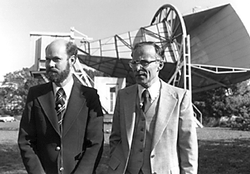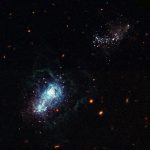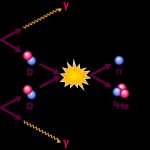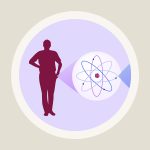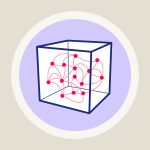Cosmology / Elementary Tour part 3: The early universe
An expanding universe, with the distances between galaxy increasing all the time, must have been much more dense, and the galaxies much closer together, in the past. The details follow from Einstein’s equations which connect the way expansions runs its course with the properties of whatever matter the cosmos contains. For realistic models, a picture emerges not only of a universe with closely-packed galaxy, but more extreme still: In the distant past, the universe did not even consist of galaxies. All its matter was in a form so hot and so much under pressure that atomic nuclei and electrons couldn’t even form atoms: a universe full of hot plasma. And in the predictions of the big bang models, that isn’t the strangest feature by far: These models predict a definite starting point for our universe’s existence, called the big bang, a bizarre initial state of infinite density.
After that crazy initial state, our knowledge of the history of the universe is on much firmer ground. To give a brief history (times always refer to time that has passed since the big bang [but see note on cosmic time]):
0 seconds – Big bang ??!?
The earliest phases of the universe’s development will be dealt with on the next page. The history of the universe given here starts roughly a millionth of a second later – from that time on, the predictions of the big bang models of modern cosmology are rather reliable.
ca. 1 millionth of a second – Formation of nucleons
Before this time, the temperature of the early universe was so high that even quarks, notoriously social particles never found today except in bound states with other quarks, zipped around freely in a hellish soup of nuclear matter. Now, the quarks combine to nucleons, more precisely: to protons and neutrons.
until ca. 1 second – Annihilation of anti-matter
Even after the formation of nucleons, the temperature of the universe was high enough to form a thick soup of particles, their antiparticles and radiation. In a way, antiparticles are the mirror images of ordinary particles, and whenever anti-matter and matter meet, say, a proton and an anti-proton, they can annihilate in a flash of radiation. In the early universe, this was an ongoing process, with particles and antiparticles annihilating, but such pairs also spontaneously coming into being from radiation. As the universe expanded and cooled, its radiation loses energy, and at this point in time, roughly a second after the big bang, its energy is not sufficient to produce any more particle-antiparticle-pairs. With the equilibrium of production and annihilation disturbed, this results in the annihilation of all remaining anti-matter. Luckily for us, there was a tiny surplus of particles, as compared to anti-particles. All
the matter we see around us, from the earth to far-away galaxies, is part of this feeble remnant of matter.
1 second – 3 minutes – Formation of light nuclei
During this time, the first protons and neutrons united to form the first stable atomic nuclei – light nuclei consisting of no more than a few protons and neutrons, nuclei such as those of deuterium (a heavy form of hydrogen) helium and lithium. The predictions of the big bang models regarding the relative abundance of nuclei formed in this early phase can be tested using astronomical observations. Prediction and observations are in excellent agreement.
300,000 years – Decoupling of radiation and matter
A time of great change for the universe: Before this time, the universe was a hodge-podge of radiation on the one hand, matter like nucleons (protons/neutrons) and electrons on the other hand. Temperatures were too high for stable atoms (nuclei with shells of electrons) to form – any atoms forming would have been ripped apart by the highly energetic radiation almost immediately. At 300,000 years, the transition: with the expansion of the universe, the temperature of the radiation has fallen to a point where it too feeble to rip apart atoms. Radiation fades into the background, and more and more stable atoms form. The background radiation ceases to interact with the rest of the universe and, as the expansion continues, it becomes colder and colder. The following photograph shows the two astrophysicists Arno Penzias and Robert Wilson:
With the help of the radio antenna visible in the background, they managed in the mid-1960s to detect the cosmic background radiation, thus confirming one of the central predictions of the big bang models.
from ca. 100 million years on – Formation of galaxies
Even before the decoupling of radiation and matter, matter had begun to clump under the influence of mutual gravitational attraction. This led to some regions of the universe having a slightly higher, others having a slightly lower than average density. The clumping continued, and roughly a hundred million years after the big bang – the exact time is unsure – the first proto-galaxies formed, precursors of today’s galaxies.
ca. 14 billion years – Now
Roughly 14 billion years after the big bang, Albert Einstein formulated his general theory of relativity – creating the tools with which modern scientists can reconstruct the preceeding 14 billion years of cosmic history.



